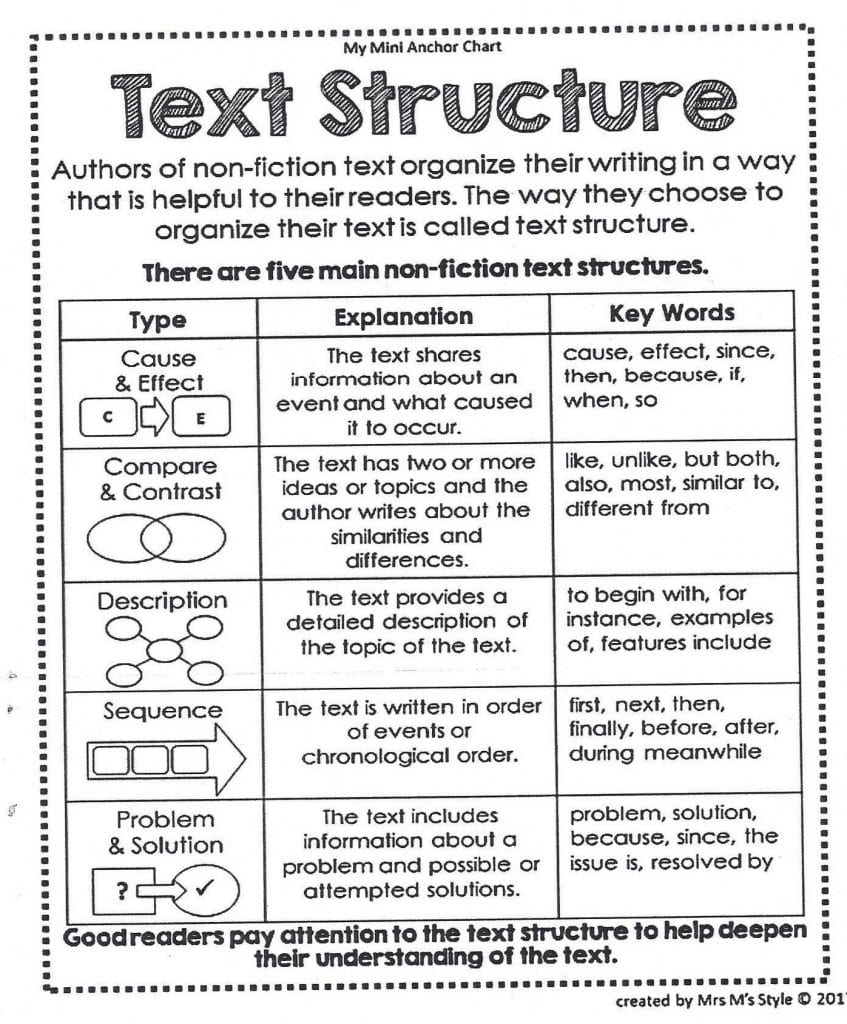by C. Elkins, OK Math and Reading Lady
I have come to realize just how important knowledge of text structures  is to almost all of the other comprehension skills and strategies. So that will be my focus for the next few posts — how this text structure connection relates to main idea, summarizing, note-taking, and writing. This post will feature the compare and contrast text structure (and some resources at the end of this post).
is to almost all of the other comprehension skills and strategies. So that will be my focus for the next few posts — how this text structure connection relates to main idea, summarizing, note-taking, and writing. This post will feature the compare and contrast text structure (and some resources at the end of this post).
What are the text structures? Most sources consider the following 5: (Picture from Mrs. M’s Style. Here’s the link on Pinterest: Text Structure Mini Anchor Chart)
- Compare and Contrast
- Cause / Effect
- Sequence
- Details / Description
- Problem / Solution
When I see reading texts that indicate the week’s skill is text structure, I cringe a little bit. Why? Well, if you are teaching all 5 of them – that’s too much to digest in one week. Here’s what I think is much more practical: Teaching about text structures should occur with each and every reading selection — and refer to the structure that is most evident regarding that selection.
Here’s an example of what the teacher might say: “This week we are reading an article titled Whales and Dolphins. This article will compare and contrast whales with dolphins. Compare and contrast is a text structure in which the author will tell ways the whales and dolphins are alike and different from each other.”
How can I further connect this to comprehension and text structure?
- Venn Diagrams or T-charts are helpful graphic organizers regarding compare/contrast text structure. Student can take notes using the graphic organizer. The idea is that with frequent use, students can eventually visualize this graphic organizer model in their head. Then this visual model serves as a thought organizer when they are not able to physically utilize one.
- I can direct my questions to focus on this text structure such as: “On page 37, can you find one way the author compared whales to dolphins?” “On page 39, the author told 3 ways the whales and dolphins are different. What did he say?”
How can I further connect this to help students with the main idea and/or a summary of a compare/contrast article? Using information from notes on the Venn Diagram, students can use sentence frames like these:
- This article compared _____________ to ______________. (main idea)
- This article compared ___________ to _____________. Whales and dolphins are alike because _____________ and they are different because ___________________. (summary)
How can I further connect this text structure to writing?
- Students use their graphic organizer notes to write complete sentences. “While whales and dolphins both live in the ocean, there are many other ways they are alike and different. . . .”

See link to this resource below.
Using a graphic organizer (as mentioned above) is also a good strategy to encourage student engagement. Writing down the information gives two ways to recall it (mentally and in writing). If the student works with a partner to do this, they have a third way (via speaking and discussing). Then coming together with a larger group to compare notes increases student engagement and lets them hear other students’ viewpoints.
Finally, try to connect this skill to other strategies (see my previous post on Comprehension Strategies).
- Use the visualize strategy to compare and contrast characters, events, or items from a text selection.
- Use the making connections strategy to compare and contrast points of view, or yourself with a character in the story.
- Use the predicting strategy to compare and contrast how different events or characters will change throughout the text.
Resources:
- Here is one of my favorite text structure articles from Reading Rockets. Implementing Text Structure Strategies
- This is one of my favorite text structure graphic organizers (FREE from Kristi Dunckelman – Pelicans and Pipsqueaks at TPT): Non-Fiction Text Structures. The graphics above are from her source.
- A great story for compare and contrast: Alexander and the Wind-up Mouse by Leo Lionni (compare a real mouse with a wind-up mouse)
- A great article featuring information on comparing different versions of fairy tales, books to movies, books by same author, etc (by Read Brightly): How to use books to teach comparative thinking
In the next few posts, I will share some other resources I feel are great for Text Structure. STAY TUNED!